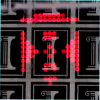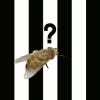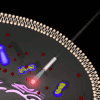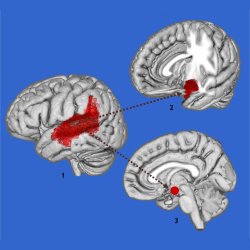-
Viewpoint on 'IONS'
Viewpoint on 'Scientific Literacy'
- Proudly sponsored by
-


-
A Brighter Future for LED Displays

The displays of the future will be stretchable, twistable, deformable into any shape, and, perhaps more importantly, durable, efficient, and cheap. This is the promise of a new approach for manufacturing inorganic light emitting devices (ILEDs).
-
Baffle the Bug!

Puzzled by the zebra’s appearance? Experimental data of recent research supports the idea that zebras developed their striped coat to stave off horseflies.
-
Spying on Living Cells

Undercover agents have been using tiny spy cameras for decades. Now, thanks to nanotechnology, researchers can also go undercover and spy on living cells from the inside.
Blue Light Beats the Blues
We all appreciate how a walk in the sun can do wonders for lifting our spirits, even though we may not know the exact scientific reasons behind the fact that sunshine helps fight the blues. Recent evidence sheds new (blue) light onto this mystery.
Blue light refracted from the sky. A consequence of modern life today is that we spend large amounts of time indoors, in spaces lit with white light. We are, however, biologically programmed for the outdoors.
La luz azul que cura los males
and Portuguese
A luz azul acaba com a tristeza,
brought to you by
Optics and Photonics Latin America
While electric lighting has made our lives better by providing our homes with artificial light, it has also meant that we have less contact with an important key to our survival — natural light. Sunlight is made up of a full spectrum of colors, which can be seen in their full glory in a rainbow. Daylight is not only important for reading a book on a park bench or for finding our way around; it also has other functions, unrelated to vision, such as that of brightening our mood on a gloomy day. But not all light is able to change how we feel with the same intensity. As shown by Gilles Vandewalle and coworkers from the Universities of Liège (Belgium), Geneva (Switzerland) and Surrey (UK), it is the light from the blue part of the spectrum that influences emotions by making our brain more responsive to emotional stimuli, and hence more easily adaptable to emotional challenges.
Two families of photoreceptors are present in the human eye: the rods and the cones. Their signals allow the brain to create vivid images of the world around us. Recently, a new type of photoreceptors — known as intrinsically photosensitive retinal ganglion cells — has been discovered to also be present in the eye [1]. Unlike rods and cones, the retinal ganglion cells are maximally activated by blue light; furthermore, they do not send signals to the brain to create images, but they fire nerve impulses that wake us up, increase alertness and boost our concentration. These effects are quite powerful: for example, workers seem to improve their performance and experience less fatigue in offices that are illuminated by blue-enriched light sources as opposed to standard white light bulbs [2].
Blue light has also been used clinically to treat people suffering from Seasonal Depressive Disorder (SAD). Also known as winter depression or winter blues, SAD is a major depressive disorder that occurs during fall and winter, and it is characterized by depression symptoms, with full recovery in spring and summer. The reason has been tracked down to the fact that, as days get shorter during the cold seasons, changes occur in the spectral composition of sunlight, with relatively less blue light present compared to spring and summer. In fact, exposing patients with SAD to blue light has proven to be effective in improving mood and alleviating depressive symptoms [3].
Despite such consistent evidence on the benefits of blue light, its underlying mechanisms on the human brain were largely unknown. Vandewalle and coworkers’ study provides us with new evidence in this regard.

Influence of blue light on the brain. When subjects hear angry voices, blue light strengthens the connections between the areas of the brain that include the voice sensitive area of the temporal cortex (1), the amygdala, a key area in emotion regulation (2), and the hypothalamus, essential in regulating circadian rhythms by light (3).
Vandewalle and coworkers’ results show that blue light promotes emotional arousal, which can help the brain to react to emotional challenges and to quickly adapt to a changing environment. According to Steven W. Lockley from Harvard University (Massachusetts, USA) this study represents "a step forward in the study of the neuroanatomy of light in humans that not only allows for a better understanding of light effects on healthy people, who benefit from blue-enriched light in various ways, but that could also contribute to the understanding of light in diseases such as SAD." Christian Cajochen from the University of Basel (Switzerland) adds that: "Light, particularly in the blue range, has beneficial effects beyond SAD. Data from other research groups and our own imply that it helps in non-seasonal depression, such as depression during pregnancy, as well as in women with personality disorders. In all future studies on mood, cognitive performance, alertness and sleep, the environmental light should be controlled in more detail, since light is such a strong potential modulator of these measures."
A consequence of modern life today is that we spend large amounts of time indoors, in spaces lit with white light. We are, however, biologically programmed for the outdoors: is it any wonder, then, that we should feel and perform better when exposed to natural light and the blue color refracted from the sky? Vandewalle and coworkers’ study shows the importance of blue light in our lives and strongly suggests that, if we cannot spend more time outdoors, then maybe we should at least consider turning our homes and offices into more blue-enriched environments.
[1] I. Provencio, I.R. Rodriguez, G. Jiang, W.P. Hayes & M.D. Rollag, A novel human opsin in the inner retina. J. Neurosci. 20, 600–605 (2000).
[2] A. U. Viola, L. M. James, L. J. M. Schlangen & D-J Dijk, Blue-enriched white light in the workplace improves self-reported alertness, performance and sleep quality. Scand. J. Work Env. Health 34, 297-306 (2008).
[3] G. Glickman, B. Byrne, C. Pineda & W.W. Hauck, Light therapy for seasonal affective disorder with blue narrow-band light emitting diodes (LEDs). Biol. Psychiatry 59, 502-507 (2006).
Joana Braga Pereira
2011 © Optics & Photonics Focus
JBP is currently working on her Doctoral Thesis in Neuroimaging at University of Barcelona, Spain.

G. Vandewalle, S. Schwartz, D. Grandjean, C. Wuillaume, E. Balteau, C. Degueldre, M. Schabus, C. Philips, A. Luxen, D. J. Dijk & P. Maquet, Spectral quality of light modulates emotional brain responses in humans, PNAS (2010) 107, 19549–19554 (link).